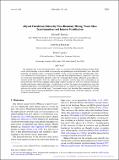Abyssal Circulation Driven by Near-Boundary Mixing: Water Mass Transformations and Interior Stratification
Author(s)
Drake, Henri F; Ferrari, Raffaele; Callies, Jörn
DownloadPublished version (2.793Mb)
Publisher Policy
Publisher Policy
Article is made available in accordance with the publisher's policy and may be subject to US copyright law. Please refer to the publisher's site for terms of use.
Terms of use
Metadata
Show full item recordAbstract
© 2020 American Meteorological Society. The emerging view of the abyssal circulation is that it is associated with bottom-enhanced mixing, which results in downwelling in the stratified ocean interior and upwelling in a bottom boundary layer along the insulating and sloping seafloor. In the limit of slowly varying vertical stratification and topography, how-ever, boundary layer theory predicts that these upslope and downslope flows largely compensate, such that net water mass transformations along the slope are vanishingly small. Using a planetary geostrophic circulation model that resolves both the boundary layer dynamics and the large-scale overturning in an idealized basin with bottom-enhanced mixing along a midocean ridge, we show that vertical variations in stratification become sufficiently large at equilibrium to reduce the degree of compensation along the midocean ridge flanks. The resulting large net transformations are similar to estimates for the abyssal ocean and span the vertical extent of the ridge. These results suggest that boundary flows generated by mixing play a crucial role in setting the global ocean stratification and overturning circulation, requiring a revision of abyssal ocean theories.
Date issued
2020-07Department
Joint Program in Oceanography/Applied Ocean Science and Engineering; Massachusetts Institute of Technology. Program in Atmospheres, Oceans, and ClimateJournal
Journal of Physical Oceanography
Publisher
American Meteorological Society
ISSN
0022-3670
1520-0485